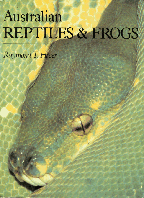
CAPTIVE BREEDING.
Justifiably so, the pinnacle of success in keeping herptiles in captivity is breeding them. As herptiles grow more scarce in the wild, and more research is carried out, captive breeding will become more important.
SEXING
In order to breed herptiles one must have specimens of both sexes. Sexing frogs, testudines and crocodiles can be difficult. Squamates are usually fairly easy to sex.
Frogs are difficult to sex. Sometimes adults of different sexes are of different sizes, or slightly different morphology. In some species the fore arms are thicker in the males, and these may even possess spikes, which are used to aid in the grip of the female during amplexus.
Excluding long necked species, most Australian turtle and tortoise species can be sexed by the presence of a distinctly longer tail present in males. In long-necked species it is common for males to have an indented plastron, useful for mounting females, but this is not a general rule.
Male crocodiles have slightly different morphological features to females, but can only be sexed by people who are highly familiar with crocodiles.
All squamates can be sexed by 'Probing'. This technique involves the placing of a blunt 'probe' into the base of the tail. In females the probe rarely travels far, as it is stopped by the flesh within the tail, usually within 3 scales of the vent. In males the probe will go further into the tail, moving into a hemipene, and generally travelling further than three scales. Probing is a very delicate operation, and should not be attempted by anyone who has not seen it performed by someone familiar with the procedure. 'Mis-probing' can make a reptile sterile.
Male geckoes can be sexed by the presence of a swelling at the anal region. Male dragons and pygopids usually possess pre-anal, and femoral pores (Tiny holes) on the underside of the hind legs.
Some male pygopids possess pelvic spurs in addition to their hind limb rudiments.
In skinks and agamids, males are often of slightly different colour to females, often with flushes of red or other bright colours.
Many large monitors will evert their hemipenes when handled.
In some snakes, males have distinctly larger tails than females.
However unless one is particularly familiar with a given species, probing is usually the only possible way to sex a snake.
To continue to the rest of this section (Initiating Captive Breeding)

The above was from the book Australian Reptiles and Frogs by Raymond Hoser and now available on a fantastic CD-Rom along with a vast amount of other information, papers and the like on reptiles, frogs and other wildlife.